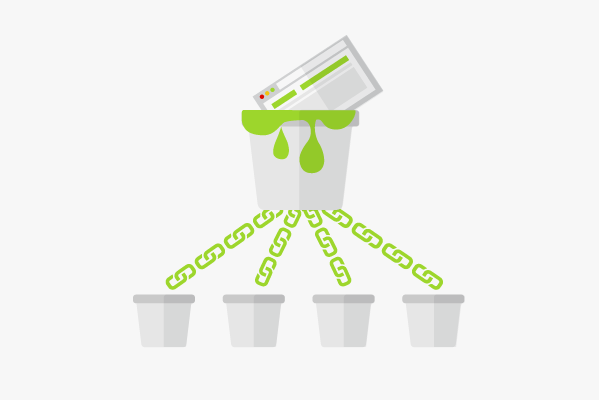Backlink is a “vote” in the eyes of search engines coming from another website to yours. Link-building is concerned with increasing the number of quality links coming to a website.
Building backlinks is one of the most effective methods of augmenting a website’s search engine ranking. Everyone requires backlinks to strengthen the authority of their online resource.
But link-building isn’t easy. You need quite a bit of time and patience, mostly because any strategy you can think of deploying is being implemented by thousands of other SEO Experts.
But that doesn’t mean you shouldn’t try. Given enough time, learning strategies about how to get backlinks will produce results, the following are particularly effective:
Table of Contents
Guest Blogging

Guest blogging is the first and most straightforward means of acquiring backlinks.
The strategy involves writing an article for another website, getting them to publish it and using that opportunity to link back to your own website.
Guest blogging will:
- Increase the traffic flowing to your website
- Increase the awareness your brand enjoys online
- Create partnerships with other individuals and websites within your field
- Generate Leads
Guest blogging performs a multitude of tasks. To make effective use of the strategy, you need to take a systematic approach that includes the following:
1. Objective
Start by creating a guest blogging strategy. This involves identifying your objectives.
- What does your website offer?
- Are there any specific products and services that you want to highlight?
- Do you have particular keywords that you wish to target?
The answers to those questions are going to inform every decision you make, especially regarding the collaborators you will target.
2. Platform
You cannot guest blog unless you have a platform upon which to publish your work. So your first tangible step should involve finding the people on whose sites you would want to be published.
Don’t rush it. Make a comprehensive list.
Use search engines like Google and social media platforms like Twitter to identify all the most influential voices in your niche.
Some people will encourage you to simply pursue sites and blogs that invite guest blogging. And that approach definitely simplifies matters.
There is no shortage of resources that openly and loudly invite people to write for them.
Try for example this query in Google: [your_niche] "write for us" or [your_niche] "contribute"
But those are the same sites every other webmaster is using.
You are better off taking a broad approach. The majority of websites on the internet are not going to turn down free content, not if it is unique and well written.
Try this instead…
Google Search
So just search for influential sites in your niche regardless of whether or not they have openly invited guest posts.
Keep an eye out for resources that have a large following, utilize effective link building strategies, and value high-quality content.
Google Image Search
1. Find someone in your niche that is known to write a lot of guest posts.
2. Copy their avatar image URL

3. Paste the URL into Google’s Image Search.
3. Approach
Once you have your list of potential collaborators, you can start contemplating your approach.
First of all, get to know your targets.
Find out what makes them tick, the sort of content they are passionate about, how open they are to collaboration, what you can bring to their table, etc.
Write a pitch that clearly states all the ways in which you can benefit their website. Most webmasters will respond positively to people that bring value to them.
Hi
[Name],I’m a long time reader. You may have noticed my comment on your post on
[Article](awesome article by the way).I’m writing to you because I’d love to contribute a guest post on
[Website].I’ve been brainstorming some topics that I think your readers would get a ton of value from:
[Idea #1][Idea #2][Idea #3]I’ll make sure the piece overflows with information that can’t be found anywhere else.
To give you an idea of the quality I’ll bring to your site, here’s a link to a guest post that I recently published on [Other Website].
Cheers,
[Your First Name]courtesy of Brian Dean
4. Write
Once a webmaster avails you the opportunity to publish your work on their website, start producing the content you promised.
Ensure that your content is relevant to the subject matter of your target website.
Make sure to write well-researched and comprehensive piece.
Use at least a few internal links, this will show the webmaster that you pay attention to his website.
You should also confirm that the site in question will permit you to include a bio and a link to your own website in the guest post.
Do not expect success overnight.
Give it a few weeks, possibly even months. Keep reaching out to new websites and writing even more guest blogs.
Eventually, the dam will burst and the traffic will begin to flow.
Niche Edits / Curated Backlinks

Guest blogging and Niche Edits are close cousins.
With guest blogging, you are creating new content and then publishing it on other websites along with your link in the hopes that new audiences will discover and follow your work back to your websites.
Guest blogging is effective but it takes time, which is why Niche Edits are so popular. With curated backlinks, rather than adding a link to newly created content on another site, you are inserting it into content that already exists.
Take a look at this illustration of backlink stats from Ahrefs.

– vs –

One is brand new page (guest post), the other is an aged page on the same domain.
The appeal of this strategy isn’t that hard to understand.
You are targeting articles that already enjoy a lot of visibility and authority. These are also articles that you know people love and frequently seek out.
So you know that any link you add to such content is guaranteed to get eyes on it.
Properly placed curated links will do wonders for your website, improving its ranking and giving it some much-needed diversity.
The level of success you can expect to achieve will depend on the method you use to acquire these curated links.
You normally have three options available to you but only two of them are ethical:
Outreach
The first method is the most honest.
If you want to insert your link into an article, you can reach out to the blog with the article and ask for permission to do so.
It doesn’t seem like the most rational approach because you probably think that most webmasters and bloggers have no reason to respond positively to such a request.
And you’re partially right.
This technique requires a lot of time and patience because some of the people you target are just as likely to ignore you.
However, a savvy blog owner won’t turn down outbound links that add value to their site, and that is actually the key to any success you hope to achieve with this strategy.
You need to convince the webmaster in question that your links will benefit their resource.
Outreach + Reward
If asking nicely doesn’t work, try sweetening the pot with money.
Reach out to your target and offer the blog owner in question a financial reward for naturally inserting your link into their content.
Or a link-back (from a 3rd website, not the primary one).
Again, as with the previous method, this one is also designed to benefit both of you. Everyone walks away happy. 🙂
Hack
The same cannot be said for so-called Blackhat niche edits.
This is where you hack a website and insert your links into an article or a blog post without the consent of the owner.
This is the most unethical approach of the bunch and you are encouraged to avoid it altogether. It looks like the fastest and easiest of all these methods but it is actually the least effective.
The moment the blog owner discovers your illegal link, they will eliminate it without a second thought. So it can’t actually deliver any long-term dividends.
Stick with the other two methods. They are slow but you can trust the results they have to offer.
You should also know that Google will detect your activities if you use too many curated backlinks. Take a measured approach.
Why are we even mentioning this approach?
There are many niche edit vendors who actually sell hacked links and you have no idea so be careful and do your research.
Private Blog Networks

A Private Blog Network (PBN) is a collection of blogs and websites that are owned either by an individual or a business entity and which you can use to generate authentic and authoritative backlinks to money sites.
PBNs are popular because they simplify the process of securing backlinks.
You have complete control over the quality and quantity of the links you acquire.
The process of building a PBN is complicated but achievable for any determined individual, and it typically involves the following:
1. Finding PBN units
a) Scraping
Start by finding expired domains. Make sure they are high-quality domains with a lifespan of several years or more ideally.
Fortunately, there are quite a few tools online that you can use to search for expired domains.
One of the most popular ones is ExpiredDomains.net.
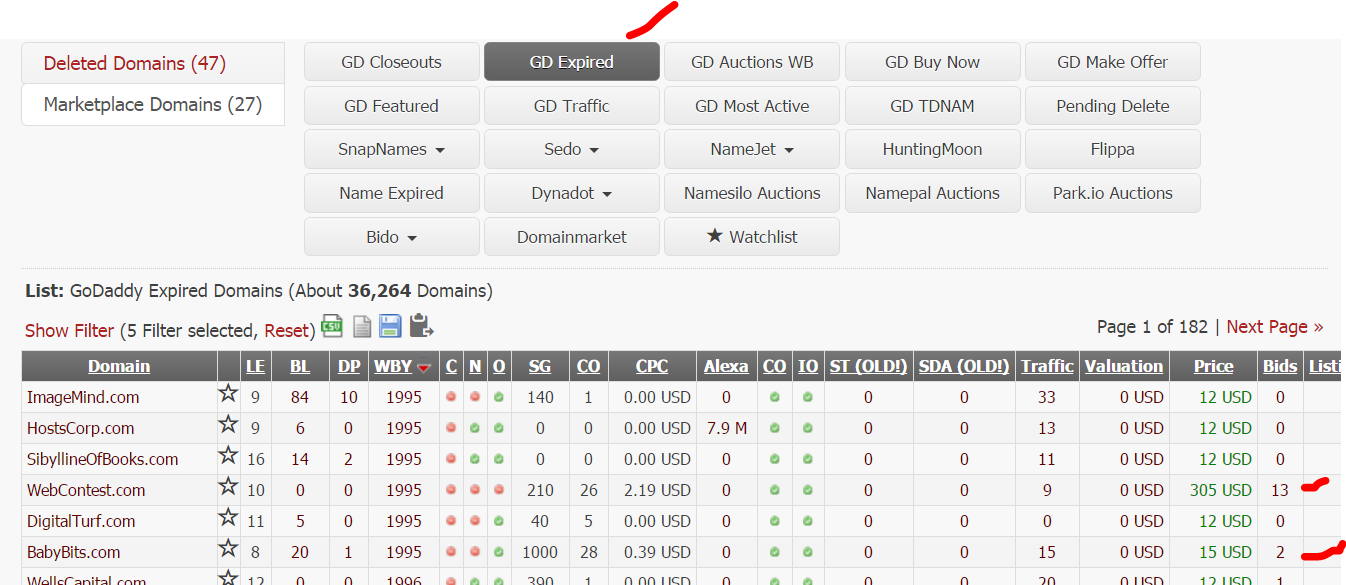
It allows you to search huge database of domains and use various filters that make life easier.
b) Vendors
The other option is more expense but extremely time effective – vendors.
You can go to domain marketplace like TB Solutions and browse their inventory of already vetted, quality domains.
You can again use filters you easily find domains you need. Especially useful is their own metric called ΣTBr (a generic indicator of power)
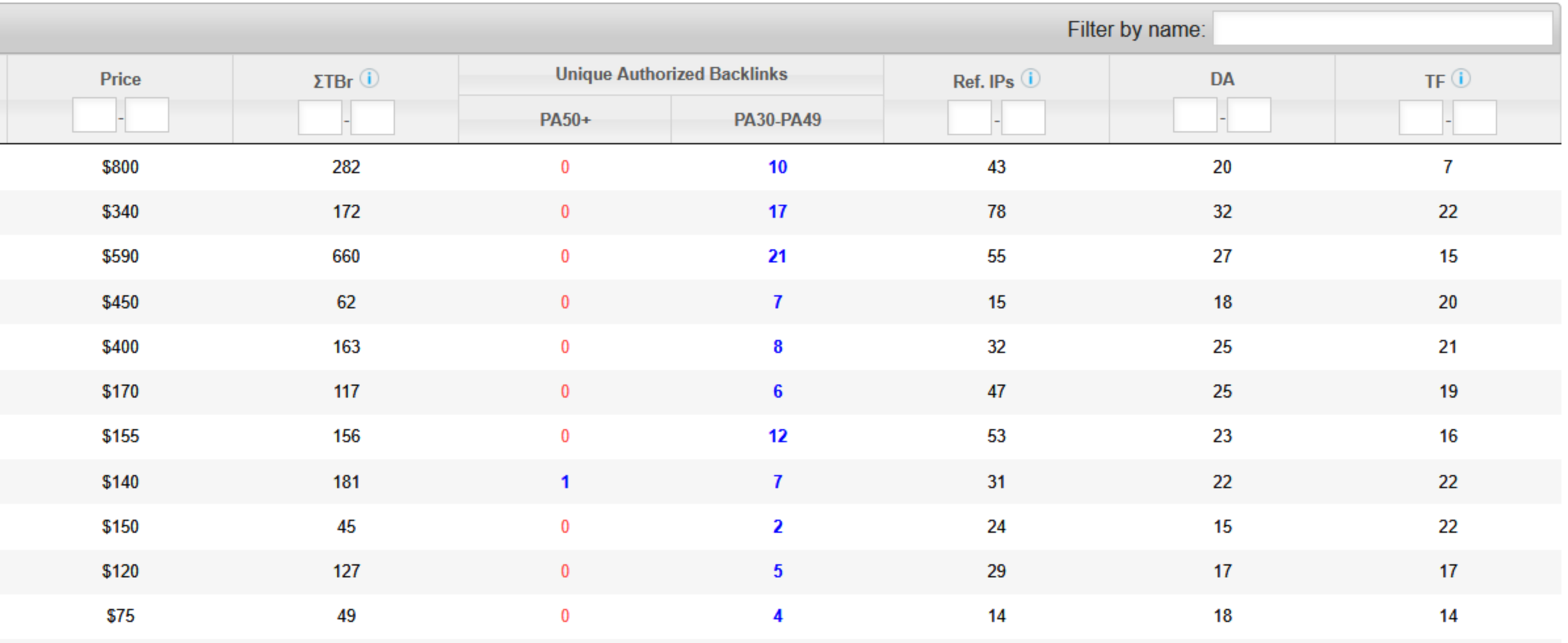
2. Registration
Once you have your domains, register them, but idieally not at the same time. Do not use the same registrar for all of them if you have more than 10.
The most important thing is to hide the fact that you are the sole owner of all domains.
You can either use WHOis protection (although it’s not really required for most domain since GDPR too effect) or you can use fake WHOis details.
Use the tool like Fake Name Generator to make this process easier.
You are also discouraged from using Google -related tools like Gmail and Chrome. The objective is to keep Google away from linking you to your domains.
3. Hosting
Start thinking about your PBN hosting strategy.
Do not use a single host for all your websites. Make sure that the individual websites are hosted on unique IP Addresses. You cannot use the same shared hosting plan for multiple domains.
Make sure that the hosting servers you use are not in the same place. You can save time by identifying a service provider that offers PBN Hosting.
Services like Priority Prospect or Easy Blog Networks make this process smooth and painless.
4. Content Management System
Next step is to choose your Content Management System (CMS).
You’ll need this because you are going to publish content with your links in regular basis and it’s a hell on earth without a CMS.
We strongly encourage you to use WordPress.
Choose a CMS you can manage and create your websites. Make them distinct enough from one another. Do not use the same themes and plugins for all setups.
Setup & Content
Make your setups and content unique.
Fight the urge to create links between the websites in your PBN. Yes, there are benefits to be had but you will also attract the wrong attention.
PBNs are a BIG no-no for search engines and if the they determine that you are using this strategy, your entire PBN and its related money sites might get into trouble.
This is why the type of PBN you choose to use matters.
A “PBN” can actually refer to either Public Blog Network or Private Blog Network.
a) Private Blog Network
Here, a single entity or individual owns all the websites in the network and he also owns the all the money sites the PBN links to.
So he enjoys all the benefits associated with running a PBN and owning a money site.
b) Public Blog Network
The concept is similar.
You still have a series of blogs and websites providing authoritative links for a money site(s).
But in this case, the Network is owned by someone else.
Webmasters have to acquire backlinks from the owner of the PBN for a fee.
T-RANKS is such a service for example.
Both options have their weaknesses and strengths.
Private Networks require a lot of work because you have to maintain all the websites in the network on top of the work required to keep your money sites going.
With a Public network, you can leave the work of maintaining the individual websites in the Network to someone else.
You simply maintain your money sites, only reaching out to the PBN to pay for the backlinks you desire.
However, Public Networks have more risk attached because the owner of the PBN has no control over the sites and blogs that his clients run, so he isn’t in a position to mitigate the risks they might attract to his or her network.
With a Private network, you control everything. So it is within your ability to ensure that neither the PBN nor the money sites draw Google’s unwanted attention.
For most people, the question of PBNs come down to whether or not they have the time and resources required to build their own PBN.
For most people, it is easier to buy links from other PBN owners.
Skyscraper Outreach

The Skyscraper technique was developed and popularized by Brian Dean.
He argued that no one walked into a city, looked at a tall building and then marveled at the fact that it was the 8th tallest in the world.
Human beings are wired to flock towards the best and Brian used that understanding of human nature to create the skyscraper technique.
His teachings are relevant today because the market is so thoroughly saturated.
It is no longer enough to simply produce quality content because a thousand other people are doing the exact same thing.
The only way to stand out is to be the best.
And the Skyscraper technique allows you to stand on top of the pyramid by compelling you to find and then improve upon the excellent work that other people have done.
To execute the skyscraper method, you need to follow these steps:
1. Linkable Assets
The objective of the skyscraper technique is to improve upon the work of other people.
So, before you do anything else, you must first locate some noteworthy content that is not only high-quality but it also boasts a healthy number of backlinks.
Search Engines
Most people just use Google, and that makes sense. Just enter the relevant keyword or [your_niche] itself to your niche into the search engine.
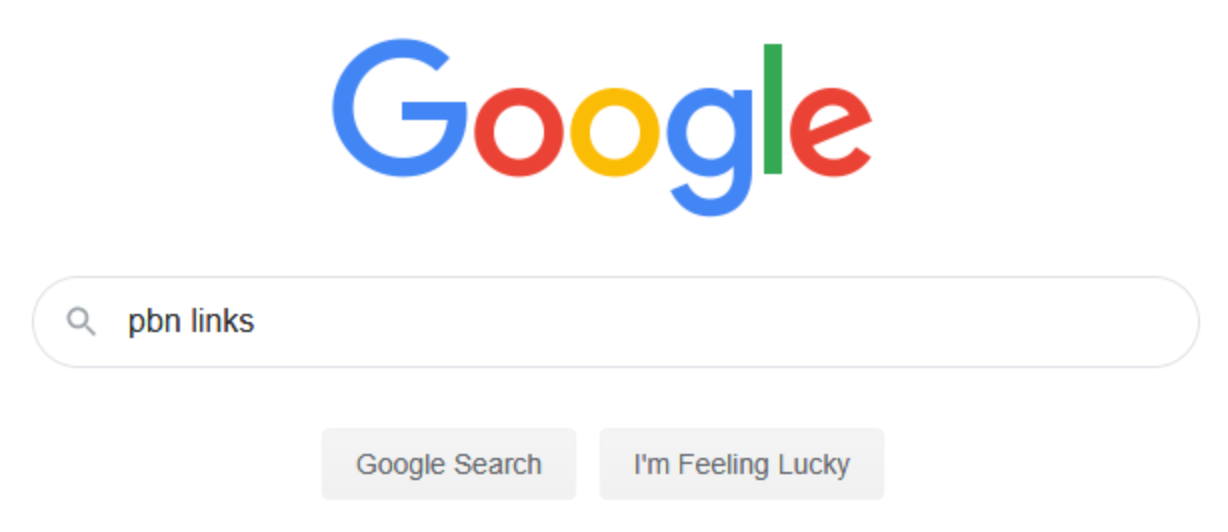
The first 30 websites in the search results are probably the most popular.

Plug those sites into Ahrefs Site Explorer and it will show you the pages that have the most backlinks.
Content Explorer
With Content Explorer, you enter the topic and it shows you the relevant pages with their corresponding backlinks.
Similar to Google search but with more data attached right away.
If you have already determined the number of backlinks you want to target, it shouldn’t take you long to find a linkable asset.

We suggest you go after at least 30 links. Size of your niche is also a factor of course.
2. Upgrade
Remember, the point of this technique is to find the best content, the articles that have the most attention, and improve upon them.
So, how can you do that?
Well, you have a few options.
You could start by making the content longer. If it is a list, make the “Top 5” list a “Top 10+” list. Once that is done, update the content.
Insert fresh discoveries, revelations, and news pieces. You can also use more recent and more relevant images. Your article has to look like the newer, better version of its predecessor.
And speaking of looks, give the design a boost. Make the layout and structure of your content stand out.
It isn’t just a matter of distinguishing your work from the original source. Your content needs to visually appeal to anyone who glances at it.
Make sure there is depth.
As with most high-quality pieces of content, yours should add value to the reader. Delve into aspects that the original article might have ignored.
All this will require as much work as you might have done if you had written the article in question from scratch.
But it’s well worth it in the end.
3. Reach Out
This is where the real work begins.
Once you have acquired the original article and given it a fresh upgrade, you must ensure that it reaches the right people.
Interestingly enough, your work is made easier by the fact that the original article had plenty of backlinks.
Rather than starting from scratch, you can just target those same people who you know love the original article.
Again, use Ahrefs Site Explorer. Enter the original URL, analyze all the backlinks displayed in the report, and sift through them to identify the best prospects.
Send out your emails.
Don’t be pushy. Just tell your targets why you are reaching out to them and all the ways that your new article is better than the piece to which they originally linked.
Do not forget to share the link to your content.
Example:
Hello
[fist_name],Recently, I was looking for some content about
[your_niche]and stumbled upon this page:[their_URL]I noticed that you link to one of my favorites posts:
[content_title]I created a similar piece and wanted to let you know.
It’s very similar to
[content_title]but updated and more detailed.Here it is:
[your_URL]Thought to let you know because it’s worth mentioning imo.
Anyway, just a quick heads up.
Best Regards,
[your_name]
And that is it.
The Skyscraper outreach technique is that simple.
If you can make significant improvements to a popular article and then distribute a compelling email to the people who linked to the original article, you cannot fail to achieve the results you desire.
Broken Link-Building

A broken link is just that, a link that is broken. When you click on it, it jumps to a 404 page. So many websites on the internet have broken links and their owners have no idea.
Many people claim that this strategy is no longer working as it has been over done.
The objective of Broken Link Building (or BLB for short) is to identify broken links, create similar content to the resource the broken link once pointed to, and then ask the site owner to replace the broken link with yours.
- identify broken links
- create similar content
- ask for replacement
Let’s dive into this:
1. Find the Broken Links
First, you are going to create a list of all your competitors or websites similar to yours in your niche.
Take note of them in the spreadsheet.
404 pages
Once you are finished, you will plug them one by one into Ahrefs Site Explorer (you can use any backlink checker but my favorite is Ahrefs)
Plug the base domain name into Site Explorer and then navigate to: Pages -> Best by Links -> 404 not found filter
Sort the results by Referring Domain count from the highest to lowest.
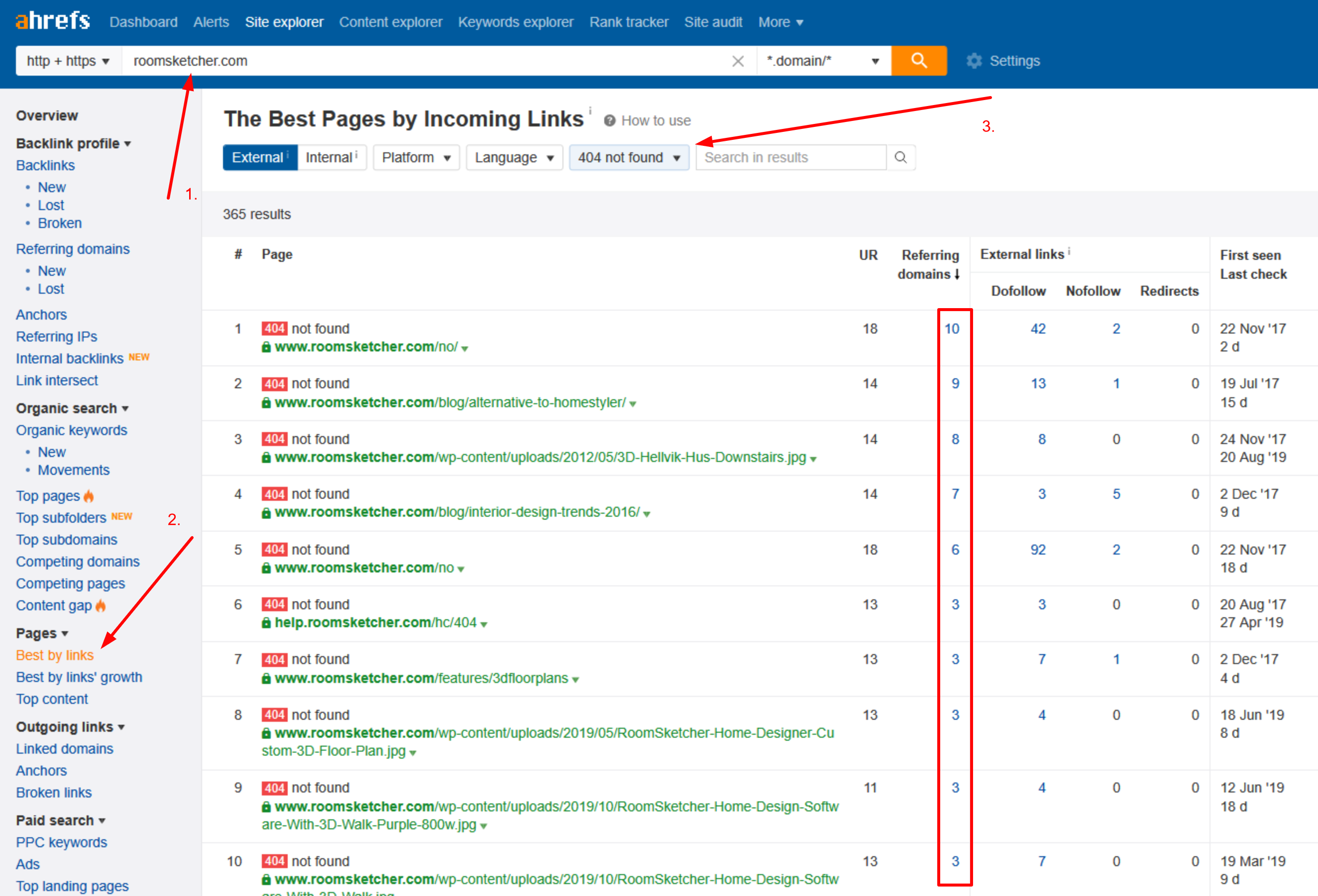
Example: Let#s say you are in the home improvement niche and roomsketcher.com is one of your competitors. This is what your research would look like:
Do you see the highlighted column under Referring Domains?
Those are your potential sources of backlinks.
For example, there are 10 pages linking to roomsketcher.com/no/ or 9 pages linking to roomsketcher.com/blog/alternative-to-homestyler/
Webmasters of all these pages have no idea they are linking to a dead resource!
Now is your chance to let them know and gain a link.
Dead Outgoing Links
Once you identify a source of broken link, analyze the page further for other linking opportunities.
We are going to use Check My Links Chrome extension for this.
This helpful app will automatically scan the page for broken links and highlight them in red.
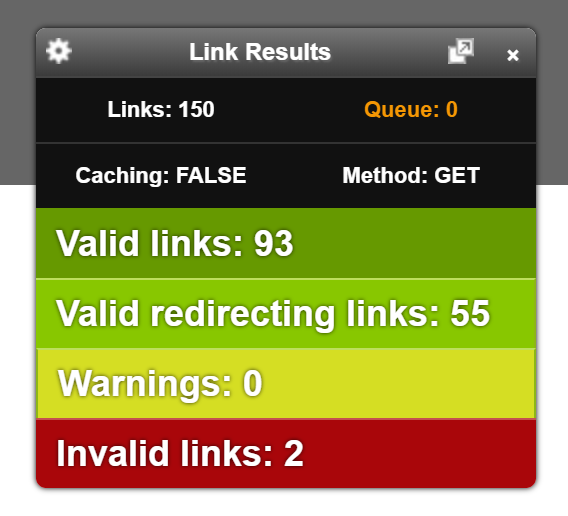
I found 1 more linking opportunity for roomsketcher.com/no/ on one of its backlinking pages:
2. Make Content
Once you have identified the broken link, you can proceed to create content to replace the resource the broken link once pointed to.
Some people create the content first and then they start searching for broken links to which that content might apply.
We don’t recommend this approach but it’s up to you.
Some people are also primarily interested in providing an alternative to the resource to which the broken link once pointed.
But others will go so far as to recreate the very same content of the dead site. Be careful with this approach because of copyright.
You can do this by finding the address of the dead site and plugging it into Archive.org to see what the original page looked like.
Archive.org provides complex HTML and CSS and sometimes even JavaScript and image files so you can simply just download the page.
Of course, if you must recreate the content of a dead site, you increase your chances of successfully appealing to the webmaster by making your new content far better than its predecessor.
3. Reach out
Once you have identified the broken links and you have produced the relevant replacement content, you can go ahead and contact the owner of the site you want to link from.
Find the right contact information and craft a compelling message. Avoid using templates. Do not make your email too generic. Use the relevant party’s name if you can find it.
Be brief.
People rarely read through long emails. So be concise. Professionalism counts. Webmasters are more likely to frown at your offer if your message is littered with grammatical errors.
A reminder or two down the line is fine. But you shouldn’t be too pushy. Most webmasters will appreciate your offer because your link will ultimately benefit their site.
You can take inspiration from the email templates mentioned before.
Important thing to note is that you should contact the right person. Ideally the site owner.
Send personalized emails instead of generic ones.
4. Monitor
Track the results of your efforts. You can use tool like LinkOkay for this.
Check your target website to see if your links have been inserted in the place of the dead ones.
Do not forget that, by reaching out to webmasters with dead links and receiving positive responses, you are also building relationships.
Use those new connections to deploy other SEO tactics.
Mimic / Research Competitor Backlinks

This strategy is very simple and straight forward. Yet often overlooked.
Creating an effective link building strategy is really difficult but only if you are starting from scratch.
You could save so much time by simply finding and using the link building strategies of your competitors.
You just have to perform a competitor backlink analysis.
You can use tools like Ahrefs, SEMRush or even Alexa.
The process normally involves the following:
1. Find your competitors
Simply enter a relevant keyword in Google and take note of the first five or even ten results.
Since these websites are ranking on the top spots, they are doing things the right way.
You are going to mimic that.
2. Analyze Your Competition
There are many tools you can use for this but I prefer these 2.
Alexa
If you are determined to work within Alexa, the tool has a feature called Audience Overlap that allows you to Find Similar Websites to your own.
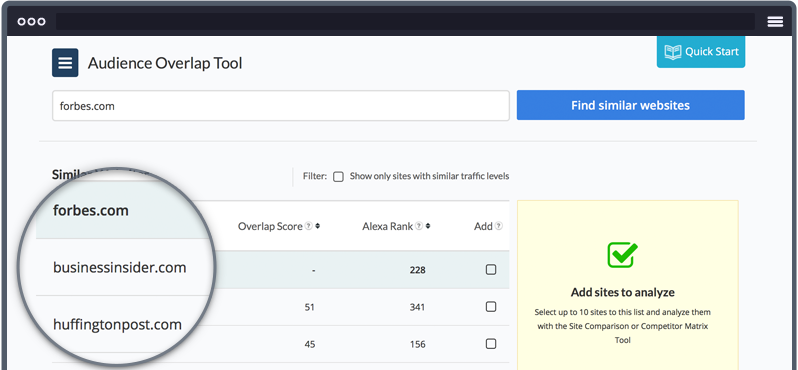
Just enter the URL and Alexa will show you all the other websites that you need to watch out for.
Audience overlap will also enable you to view the number of backlinks each competitor has. Just use the Site Comparison feature.
By looking through the report provided, you will identify the competitors with the healthiest link portfolios.
Such competitors have the strongest linking opportunities, so they will become your targets. Take note of them.
Use the Competitive Analysis tool to determine the authority of the linking sites.
Pay attention to the corresponding Alexa Rank. The higher the page authority of the linking site, the better.
This will enable you to narrow your targets even further. If you have the time, use the Competitive Keyword Matrix in Alexa to look at the sites that are linking to your competitors.
Ahrefs
Similar process goes for Ahrefs.
Simply plugin the competitors one by one into Site Explorer. Then navigate for Backlinks tab.
What I like to do is sort the backlinks by One link per domain feature.

This way, you will focus on the strongest link from each website. Getting more links from the same websites gives diminishing returns anyway.
You can also use Domain Comparison tool to compare your top 5 compeitors. It’s located under More i nthe menu.
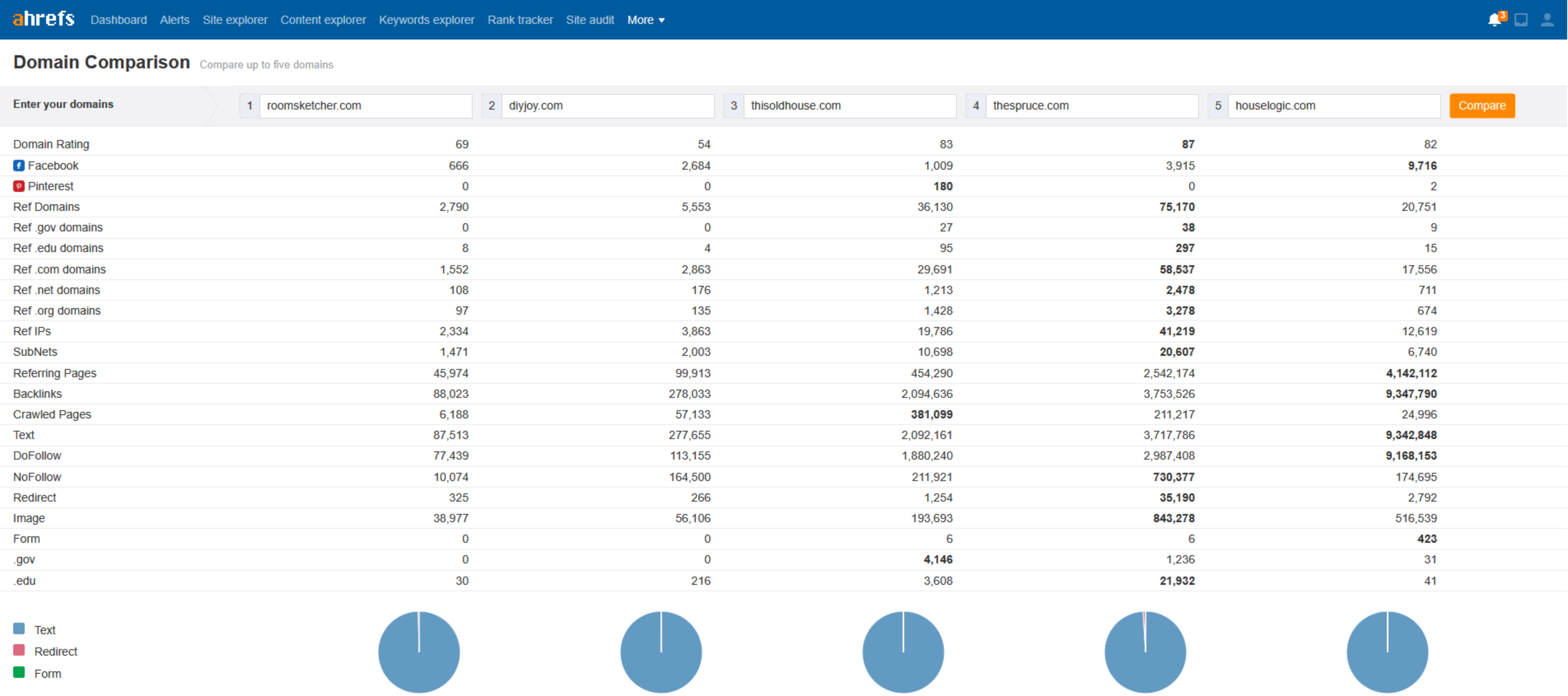
Get a quick overview of what is going on.
3. Form a strategy
At this point, you should have all your data on hand. You should have eliminated the weak and harmful links. So all that is left are the high-quality options.
You know where all your rivals links come from. You know the websites that are funneling traffic to them.
Create a link building strategy that can utilize all this information. Find a way to use the websites that are sending link juice to your competitors to do the same for you.
If your competitor keeps generating attention in forums, join similar discussions to incite similar interest.
If your competitor slipped a number of guest posts into the web pages of influential publications, reach out to these same platforms and pitch your own guest posts.
Sometimes, the easiest way to succeed is to mimic successful people.
Look at every link that has made your competitor a star and reverse engineer it.
You are not technically “stealing” links. This tactic is perfectly ethical.
Editorial Links

These are the most powerful links you could ever acquire.
This is because they are given naturally to without the owner ever paying or begging for them.
They are offered freely and this makes them more impactful to because it tells the search engines that your webpage has something special to offer.
Popular news sites give away these links very often for example when they talk about celebritues and link to their website.
Examples of these are well knows giants like: Forbes, CNN, HuffPost, BBC, New York Times and many others.
To be clear, these natural citations don’t have to be positive.
Even a negative mention on a trusted news publication will do more wonders for your website’s traffic and rankings than an ordinary guest post.
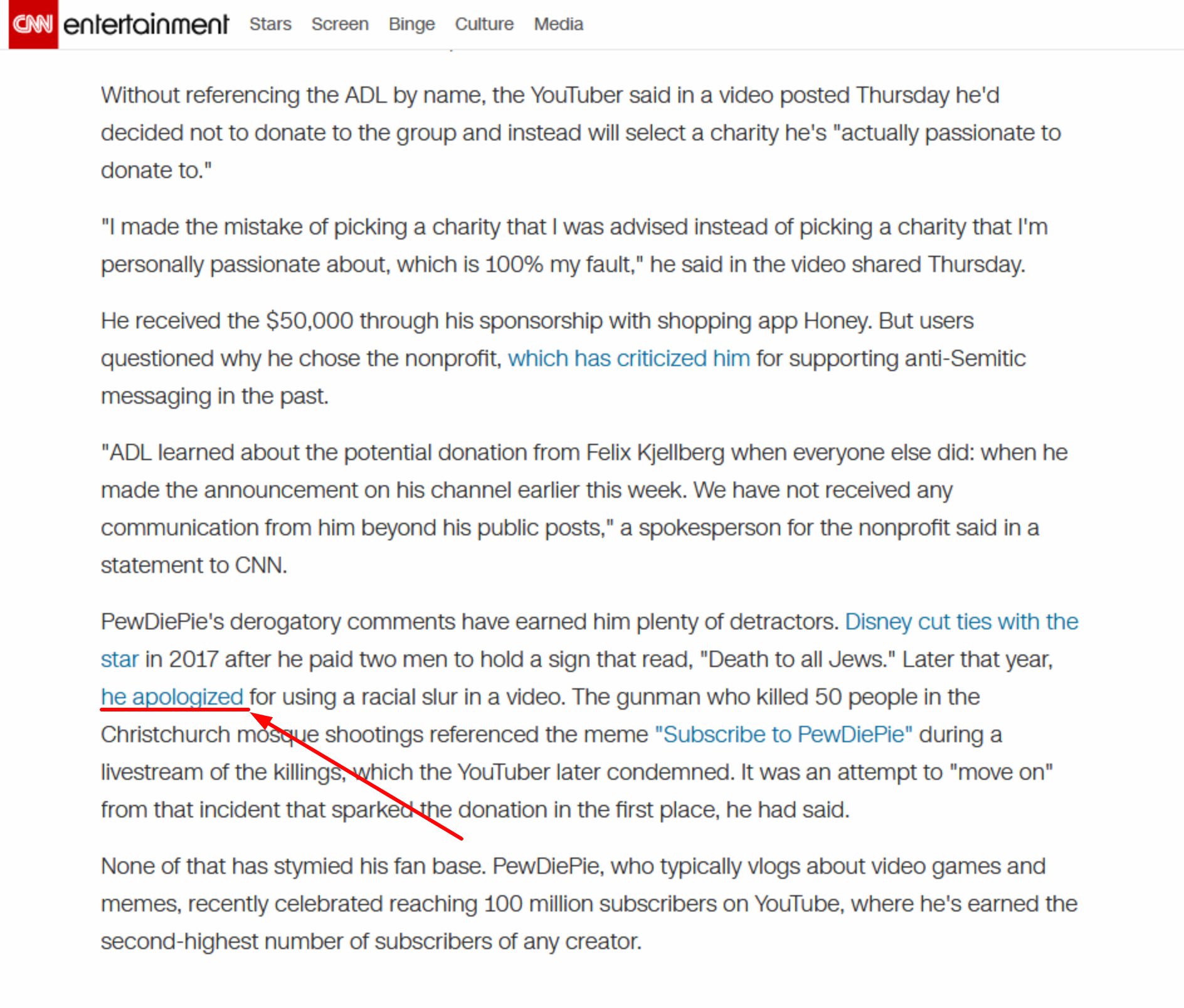
Look at this example of CNN post about PewDiePie: https://edition.cnn.com/2019/09/13/entertainment/pewdiepie-donation-adl-trnd/index.html
It’s very negative, however, links to one of his videos. In terms of SEO this is a win. And I’m 100% sure he didn’t ask for it 🙂
It is worth mentioning that, while Editorial links are supposed to be voluntarily given, it is also possible to secure an editorial link by requesting to naturally link to your page.
In other words, you can either attract an editorial link or you can propose it.
Regardless of the approach you take, an authoritative blog or site will only voluntarily link to your content if:
- The content is so rich that they find value in spreading it to their readers.
- The content mentions them in some capacity.
- They have a relationship with the content creator.
- The content is clever, well-written, and detailed
- The content is unique and thoroughly researched
- The content is relevant to the core theme of the authoritative site.
- The content is shocking in terms of presenting an angle no one has ever explored.
Authoritative websites tend to respond positively to articles that are controversial, educational, and emotionally captivating.
They also appreciate content that has no strings attached. You are not asking for money or favors of any sort.
If you are struggling to earn editorial links naturally, try the following:
1) Create content that is actually worth linking to. Make it relevant and newsworthy.
2) Look at your competition. Analyze all their content that happens to attract editorial links and produce something in that same field but even better. Add more depth and insight.
3) Find people that your target authoritative site cares about and record interviews with them. This will draw the attention of everyone who has an interest in the interviewee. You can also trust the interviewee to spread your fame.
Unlinked Mentions

Unlinked mentions are aptly named.
The term basically refers to a situation where a web pages has made mention of your brand but they did not bother to include a link.
Currently it’s just a text.
Webmasters are always fighting to get other websites mention theirs. But a simple mention doesn’t go far enough. In terms of SEO at least.
You also want a link that visitors can simply click and follow back to your own page.

You can use Google Alerts to receive notifications of any mentions of your brand, especially on social media.
But this applies for future mentions in most cases. To find the current ones you need to take a different approach.
Tools like Ahrefs’s Content Explorer will perform much better. In this case the “topic” will be your brand.

For this example we’re going to use our brother LinkOkay. Make sure to search only “In content“.

Content Explorer has an awesome feature that make this process a breeze. It literally highlight all pages that mentioned your brand but did not link to you.
Once you discover a brand that mentioned you but did not provide a link, you have the option of asking the publication in question to remedy the situation.
But you need to make sure that your request has merit.
Sometimes, a publication failed to insert your link simply because they forgot.
Other times, any information visitors might have gleaned by visiting your website was already presented in the publication’s article.
If you are certain that your brand’s mention merits a link, reach out to the person who produced the content or the editor.
This is called link reclamation.
Make sure you point out the article that mentioned your brand, the link that is missing, and the value the link adds to the publication’s readers.
Best, Top & Competitors Lists
Have you ever seen an article titled something like this?
- “Best SEO Tools You Must Use”
- “Top 10 WordPress Themes 2019”
- “10 Cheapest Hosting Providers”
I am sure your product or service falls under one or more of such list categories.
Your product is the best, right? 😉
Then you could easily get a backlink from lists like this. It’s almost like a niche edit. A very nice, contextual backlink from an aged page. Furthermore, I’m sure your competitors are already listed there.
To get included on these lists follow this simple 2-step process:
- Find the lists (linking opportunities)
- Reach out to webmasters
1. Finding the lists
#1 Search engines
You can use this Google search query:
best your_niche -your_brand
Example:
best backlink trackers -linkokay
#2 Competitors
Second option is to reverse engineer your competitors backlinks.
If they are already included in top/best list, their backlinks will be visible in Ahrefs.
Simply go to: Site Explorer -> Backlinks -> filter by word “best“
2. Reach out to webmasters
A simple email along the lines of this should do:
Hello
[NAME],Mark here from
[your_company].I see you have a detailed list of all our competitors (here).
Any particular reason
[your_product]is not in the list?Just wondering… 🙂
Anyway, I’m kinda glad you didn’t include us because it gives me opportunity to introduce
[your_product]which I strongly believe you’ll fall in love with 🙂
[a_single_sentence_of_very_short_product_description_and_benefits]Could you add us to that post by any chance?
Regards,
[your_name][your_company]
Give your own twist to the email.
BONUS #1
Link Round Ups
One interesting way to get backlinks is to create link roundups. This is where you make an effort to draw attention to yourself by creating content that highlights other people and their content.
The hope is that, by giving these bloggers and webmasters attention, they will reciprocate.
For those who are not in the know, the point of link roundups is to create lists that constitute posts from other people. It’s a similar tactic to the best / top lists mentioned before but with a little twist.
For instance, you could create a list of the “Ten Best SEO Guides” on the internet or the “Top 20 On-age SEO Factors” lists generated by other bloggers. By adding the content of other bloggers and webmasters to your site and including them in a list, you are showing that you value and respect their work.
This is going to get you noticed.
First of all, the writers of the articles and blogs you mention in your lists are going to link to your content. This is going to drive traffic & juice towards your site. Secondly, link roundups create an opportunity for you to pursue relationships with other bloggers. You don’t even have to wait for some of these people to naturally link to your site.
They are unlikely to reject you if you make a formal request. This is because they recognize the mutually beneficial nature of any collaboration they might choose to pursue with you.
Link roundups are nothing new.
Bloggers use them all the time. However, they normally use this method to highlight their own pages or posts on other sites that they own. If that sounds like you, it is high time you expanded your reach to encompass other bloggers. The more attention you shower other bloggers, the more attention they will send your way.
Just so you know, link roundups take time. You can’t just throw any random list of links together. Like all other content, any list of links you create must add value to the reader. This is going to force you to carefully study the posts you intend to include in your roundup. Make sure you can explain why every single link in your list is relevant to your niche and your readers.
BONUS #2
Internal Links
Most people understand the importance of backlinks. However, most people do not understand the importance of internal links. This is despite the fact that most websites have internal links of one sort or another.
To search engines, internal links are absolutely essential. The search engine uses them to determine the structure of your website.
When search bots approach your website, they will land at the homepage and then follow the links to the different inner-pages, slowly but surely building a picture of the relationships connecting the various aspects of your platform.
Google itself will tell you that it discovers pages by following a link from a known page on the website to a new page on the same website.
So a page without an internal link might as well be invisible.
Matt Diggity talks about importance of internal link optimization in his anchor text optimization posts. He shares a story about internal anchor text and how its over-optimization cost him a lot of money.
If you are looking to create an internal link building strategy, this is what you need to know and understand:
- Google uses your internal links to navigate your website and to understand the relationships between the different pages and posts. So the more internal links you have the better.
To create an optimal number of links, you need content in optimal quantities. Create as many relevancy, high quality pages as you can. This will give you an “excuse” to create many internal links. Obviously, your content must be linkable.
You can’t just create and link random articles with no connection whatsoever to one another. Your internal links should allow your readers to flow cohesively in and out of your content.
That’s why it’s beneficial to always stick to your topic. This way all articles are related one way or another and inter linking is easy.
- Do not forget to include anchor text or alt attributes if you are using images.
Keep it natural. Do not over-optimize. Keep things simple. Put naked URL, brand and misc anchors into the mix.
- Do not waste time adding links to pages that are easily accessible via the main navigation menu.
In most cases, your links need to go deep. They need to draw readers into those corners of your site they seldom visit. The idea is to have your entire website completely mapped and accessible from a variety of points.
You can help search engines with this by generating a sitemap and then inducing link to it in a menu, usually a footer.
- As was mentioned above, your links need to be relevant. Make sure that a tangible connection exists between the pages you have chosen to link.
The reader has to find more value by following your link.
Otherwise, you are just as likely to incite irritation in your visitors. You must learn to organize your website into categories where topics with similar themes are clustered together and, thus, linked.
This will simplify navigation for your users whilst also helping the search engine understand the context of the content on your platform.
You can also bring your internal links and site structure to the next level by utilizing silos. A silo is a specific site structure where you strick stick to one topic. You don’t ever interlink silos. Original silo strategy was invented by Bruce Clay.
Every so often, you are encouraged to carry out an audit of your site. It will help you ensure that all the internal links you have put in place are relevant.
You will also identify broken links, internal links to pages that are not important and orphan pages that do not have internal links coming to them.
Conclusion
Link building isn’t rocket science.
You have more resources today teaching beginners how to link-build than at any other point in time. So there is no shortage of learning material. But link building is hard and you can’t succeed unless you are determined to persevere.
Then again, tools like Alexa and Ahrefs which simplify the process are so rife these days that no one has any satisfactory excuses for either refusing or failing to build backlinks.
